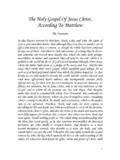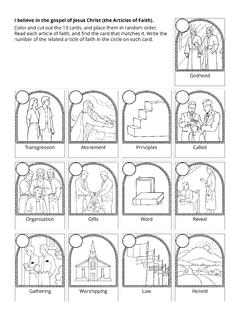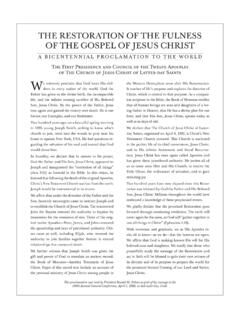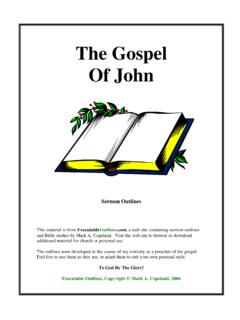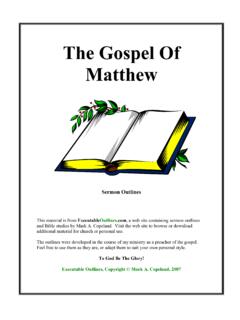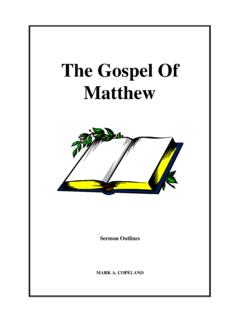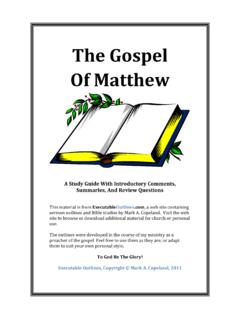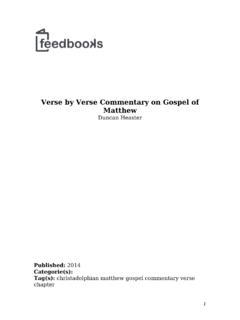Transcription of The Gnostic Gospel of Thomas: A Lost, Secret Vision of Jesus
1 "The Gnostic Gospel of Thomas: A Lost, Secret Vision of Jesus "Earl RichardLoyola UniversityYamauchi LectureOctober 17, 1993 The recent discovery and current interest in the Gospel of thomas have elicitedconsiderable popular and scholarly attention, a phenomenon which shows no indicationof coming to an end. The above title seeks to underscore some important facts whichhave propelled this ancient work to relative prominence in the public ) thomas presents a portrait of Jesus which at one point in the church's historywas popular but which the historical process and time have either judged non-mainstream or have simply forgotten. thomas and its Secret Vision of Jesus , along withmany other ancient images, became the victim of a process which tends to synthesizedifferences and impose uniformity, but still searchs for new and exciting images.
2 Some ofthe old images persist but new generations seek or create new ones or are often fascinatedby earlier ones--so interest in ) The recent finding of thomas reminds us of an important aspect of modernity,its ability through archaeology or historical research to rediscover and the possibility of itsbeing challenged by lost texts and ideas. Powerful images and visions of the past may notbe irretrievably lost. Besides, there is often a fascination with ancient 3) the Vision of Gnosticism continues to appeal to a wide range of minds as ithas done throughout the centuries. The discoveries accompanying the finding ofThomas have generated interest in the subject of dualistic thought and the themes of eviland salvation on the part of scholar and lay person.
3 thomas is obviously concerned , having chosen to speak of thomas , a text which has almost attained cultstatus in the popular mind, it is my intention to approach the subject in the following presentation will have four parts of unequal length. First, there will be a substantialexamination of the text's history, rediscovery and relation to the Jesus tradition; someimportant facts need to be presented here. Secondly, I will dwell briefly on the formationand history of the Gospel of thomas , including its origin and Gnostic editing. Thirdly,by means of an analysis of the text or thomas , I will attempt to articulate at some lengthits unique Vision of Jesus and his role in helping believers address the vicissitudes of thehuman condition. In this section I will refer frequently to the text of Thomas1 to allowthe reader to become acquainted first-hand with it and to allow a clearer sense of itsmessage and portrait of Jesus .
4 A brief fourth section will offer a closing Rediscovery of thomas and Its Relation to the Jesus Traditiona. Early History and Rediscovery. Before the reappearance of the Gospel of thomas among the Nag Hammadicodices in 1946, there existed from various early Christian writers limited but tantalizingreferences to and citations from popular thomas literature, that is, traditions and textsassociated with the apostle thomas , whether childhood narratives, sayings sources, acts,psalms, or apocalypses associated with the A Gospel of thomas was known tothe second-century writer Irenaeus who cites childhood episodes from it and states that itwas used by a late Christian Gnostic group, the Marcosians. Other references to aGospel of thomas are made by the great Alexandrian biblical scholar Origen in his firstLukan homily and the mid-fourth-century bishop Cyril of Jerusalem.
5 The former citesthis work in support of a philological point but the latter warns against it, saying that itwas in use among the well-known Gnostic group, the Manichaeans. But more importantto us is a second-century citation by Hippolytus said to be from a Gospel of thomas ,which reads: "the person who seeks me will find me in seven-year-old children; for hiddenthere in the fourteenth age, I am revealed."3 This passages has a vague resemblance toThomas saying 4 about seven-day-old Nonetheless, since no such saying wasfound in the childhood Gospel referred to by Irenaeus, recent scholars had to assume theexistence of another Gospel attributed to thomas . These Gospel references thereforewere to the Infancy Gospel of thomas , on the one hand, a well-known narrative aboutJesus the wunderkind or child prodigy and, on the other, to another Gospel which latercame to be identified with the Coptic thomas we are next stage in the history of the Gospel of thomas brings us to the end of the19th and beginning of the 20th centuries when, as the result of archaeological excavationsby Grenfell and Hunt of the ancient Egyptian town of Oxyrhynchus (modernBehnesa, c.)
6 120 miles south of Cairo), there was recovered literally bushels of Greekpapyrus fragments. From an ancient third-century dump there emerged textualfragments of great variety: official documents and correspondence, non-literary notes andpersonal letters, as well as other literary fragments including parts of Matthew, Paul, 1 John, and the Book of Revelation. So impressive was this documentary find that by 1983nearly 50 volumes of Oxyrhynchus papyri had appeared with Greek text, introduction,and notes to over 3400 items. Important for our study was the discovery in the Winter of1896 (with its publication the following year) of a fragment (P1), which contained eightinteresting "sayings of our Lord." The epigraphers dated this fragment to c. 200 years later in 1904 there appeared two new fragments, P 654 and P 655 datedrespectively to the mid-to-end of the 3rd century and to c.
7 250 these discoveries, there ensued debate and much conjectureconcerning the source, identity, and content of these new fragments. These along withother fragments such as Papyrus Egerton 2 and the independent Papyrus Oxyrhynchus840, have been compared to or associated with the Q-Source (that is, Matthew andLuke's saying source), the logia referred to by the Christian writer Papias, and a variety ofearly apocryphal gospels (whether of the Egyptians, Hebrews, or Ebionites).Matters remained thus until the important discovery in 1946 of the Gospel ofThomas among a large cache of Coptic, mainly Gnostic , treatises. The discovery wasmade near ancient Chenobaskion, near modern Nag Hammadi (c. 60 miles northLuxor). Interestingly, the manuscript find was made near the traditional site ofPachomius' cenobitic monastery; in fact the 12/13 codices, containing 52 treatises, wereprobably discovered in a large jar buried in a nearby monastic cemetery.
8 While the storiesof the discovery and of the intrigue surrounding the early handling and subsequentpublication of these almost rival those of the contemporary Dead Sea Scrolls finds,5 thehistory of the Gospel of thomas was considerably simple. Its text was made available tothe scholarly world in 1956 in a volume containing photographs only of the papyrus sheetsof parts of codices I and II, thomas consisting of plates 80-99 of that in a variety of languages began to appear in the late palaeographic terms, thomas appears on 20 sheets or ten leaves of papyrusfrom Nag Hammadi codex II. Its language is the central Coptic dialect of Sahidic with amixture of Akhmimic forms (another Coptic dialect). The text is relatively well preservedand has few, generally restorable, textual breaks.
9 The generally acceptable, conservativedating of the Coptic version is c. 400; the composition would of course have been muchearlier. The connection between the Oxyrhynchus fragments and the Gospel of Thomaswas soon recognized by scholars and provided with extensive comparative study It is now generally accepted that Oxy P 654 corresponds to the prologueand first five sayings of thomas , that Oxy P 1 offers sayings 26-30 and 31-33 but with anintrusive fragment of saying 77, and that Oxy P 655 consists of sayings 36-39. It is furtherconcluded that the three fragments represent three different and differently dated copiesof the Greek version of thomas . Additionally, it is increasingly admitted that the Greekof Oxyrhynchus offers various editions of early thomas (note the order of sayings in OxyP 1) and that the Coptic is a Sahidic translation from a Greek thomas ' Relationship to the Jesus Tradition.
10 In thomas one finds not Synoptic-like narratives which are the hallmark of thegospel tradition but rather a loose collection of prophetic, parabolic, and other didacticsayings (often in the form of question and answer), and usually introduced simply by" Jesus said." But it is not this virtual absence of narrative material which has causedsurprise and created debate. Indeed, the Q-Source, Matthew and Luke's non-Markanresource, presents just such a phenomenon. Instead, scholars have been struck by theodd juxtaposition of sayings that have close parallels in the Synoptics and others that bearno contacts with that tradition. Thus, two very different solutions have been proposedfor this anomaly. Some, by far the minority, have seized upon these similarities and theseemingly primitive, non-allegorized state of some of these sayings to argue for a traditionindependent of and even older than that represented by the Gospels of Mark, Matthew,and Luke.


